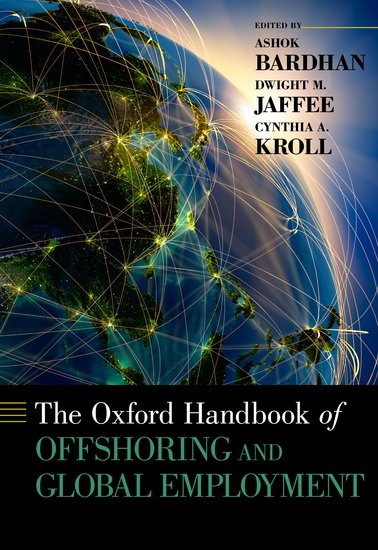
How do globalization, economic growth and technological developments interact to impact employment? This Handbook brings together eminent authors from a wide range of countries to assess how global economic changes have affected employment opportunities. Chapters cover both manufacturing and services sectors, and also address policy issues regarding innovation and job creation. One of the book’s strengths is the inclusion of chapters by developing-country scholars that tell the story of globalization from their nations’ perspectives, writes Jennifer Miller.
 The Oxford Handbook of Offshoring and Global Employment. Ashok Bardhan, Dwight M Jafee & Cynthia A Kroll (eds.). Oxford University Press. May 2013.
The Oxford Handbook of Offshoring and Global Employment. Ashok Bardhan, Dwight M Jafee & Cynthia A Kroll (eds.). Oxford University Press. May 2013.
As the debate on US immigration reform gathered momentum this spring, one of the most hotly contested topics has been policies for high-skilled workers in STEM fields. Mark Zuckerberg’s advocacy group FWD.us represents the position of many tech industry employers seeking relief from abroad for what they describe as critical skills shortage. However, Congress has also heard testimony that current immigration policy already creates unfair competition for domestic STEM workers in an environment of surplus rather than shortage. One topic neither side of the debate tends to emphasize, however, is that the movement of workers is only half the story. It is not just manufacturing and call centres that can move offshore—companies are increasingly moving R&D abroad as well.
As The Oxford Handbook of Offshoring and Global Employment aims to provide a comprehensive overview of its subject, I was especially interested to see what the book had to offer on the topic of R&D offshoring. The editors, Ashok Bardhan, Dwight M. Jaffee, and Cynthia A. Kroll, all of the Fisher Center for Real Estate and Urban Economics at the Haas School of Business, University of California, Berkeley, draw on an impressively global group of over 40 expert contributors from at least 15 nations.
The book is organized into four geographically-defined sections, beginning with developed economies, continuing through the BRIC countries (Brazil, Russia, India, China), and concluding with a section on other developing countries in Latin America and Africa. Thematically, the book focuses on what the editors call “the four guiding elements of the global economy of our time—free markets, globalization, nation states as the unit of policymaking, and governments that respond to the demands of their citizens” (p. 22). While this review focuses on chapters addressing high-skill service-sector offshoring, the Handbook’s chapters cover the full spectrum of employment-related offshoring topics from manufacturing to assembly to IT services.
For an overview of the Ricardian theory of comparative advantage that provides the economic rationale for international trade, the second chapter, by Ralph E. Gomory and William J. Baumol, is highly recommended. While acknowledging the power of this theory based on gains from specialization, they also point out several common misconceptions, including the surprising prospect of productivity improvements in one country harming its trading partner. The chapter concludes with specific consideration of the US STEM sector. Interestingly and in contrast to much contentious debate from both sides, they claim to find neither labour surplus nor shortage of STEM workers. However, they are concerned that innovation arising from the STEM sector will not succeed in strengthening the broader labour market without policy reform. Gomory and Baumol emphasize the importance of retaining some innovative manufacturing domestically and outline a creative policy alternative based on tradable permits.
In Chapter 8, Matthias Deschreyvere and Jyrki Ali-Yrkko present empirical evidence from Finland about how firms’ offshoring of R&D affects domestic employment. This chapter provides good exposure to the types of data some governments are beginning to gather about offshoring as well as the particular challenges in measuring R&D offshoring. The authors are forthright about the limitations of their data, including small n and low reliability of the key independent variable, but their conclusions suggest positive effects on domestic R&D from offshore outsourcing and negative effects from captive (within the firm) offshoring. These findings highlight the importance of treating outsourcing and offshoring as distinct phenomena.
Australia’s quarter-century of treating higher education as a service export industry is the focus of Chapter 14 by Christopher Ziguras. While the offshoring of higher education can take many forms, one of the fastest growing is the international branch campus, which extends its mission beyond teaching to research. Leading exporter countries in this sector are Australia, the US, and the UK, with campuses concentrated in the Middle East and Southeast Asia. Australia’s leadership in this sector and the large impact on Australia’s economy, with education as its third largest export industry, provide an excellent example of the local and path-dependent nature of offshoring’s economic effects, a theme the editors highlight throughout the Handbook.
Some policy implications for the US are provided at the conclusion of the introductory chapter. The recommendations are motivated by two key questions about how innovation can be harnessed to stimulate the national economy: “First, how can innovation be promoted? And second, how can it be ensured that it will lead to significant job creation?” (p. 21). While this reviewer found these recommendations extremely relevant, presenting policy implications solely for the US may be somewhat disappointing to other readers. One of the book’s strengths is the inclusion of chapters by developing-country scholars that tell the story of globalization from their nations’ perspectives. The authors are careful to qualify their recommendations, as one of the key implications from this collection is that the employment effects of offshoring are country-specific and do not lend themselves to a simple typology of advanced, emerging, and developing economies.
—————————————————
Jennifer Miller is an Assistant Teaching Professor at the University of Southern California’s Sol Price School of Public Policy. She received her doctorate in public policy from the University of North Carolina at Chapel Hill. Her research interests focus on the scientific workforce. She has also written about collaboration among universities, industry, and government in university research centres. Before pursuing her doctorate, she worked for IBM in human resources. Read more reviews by Jennifer.








1 Comments